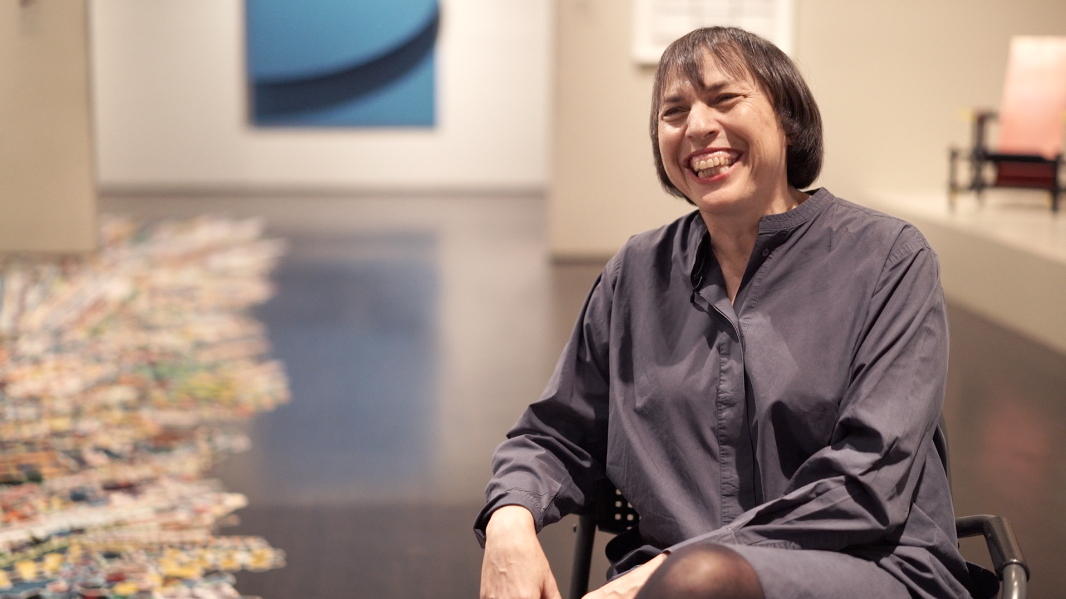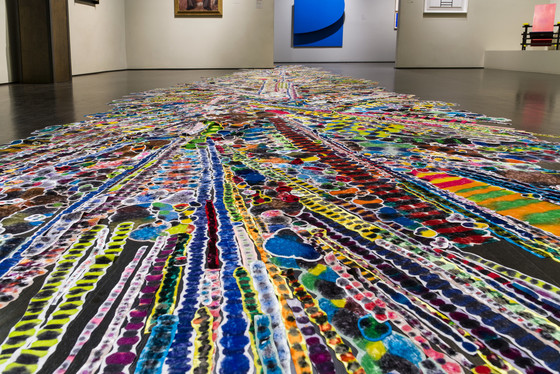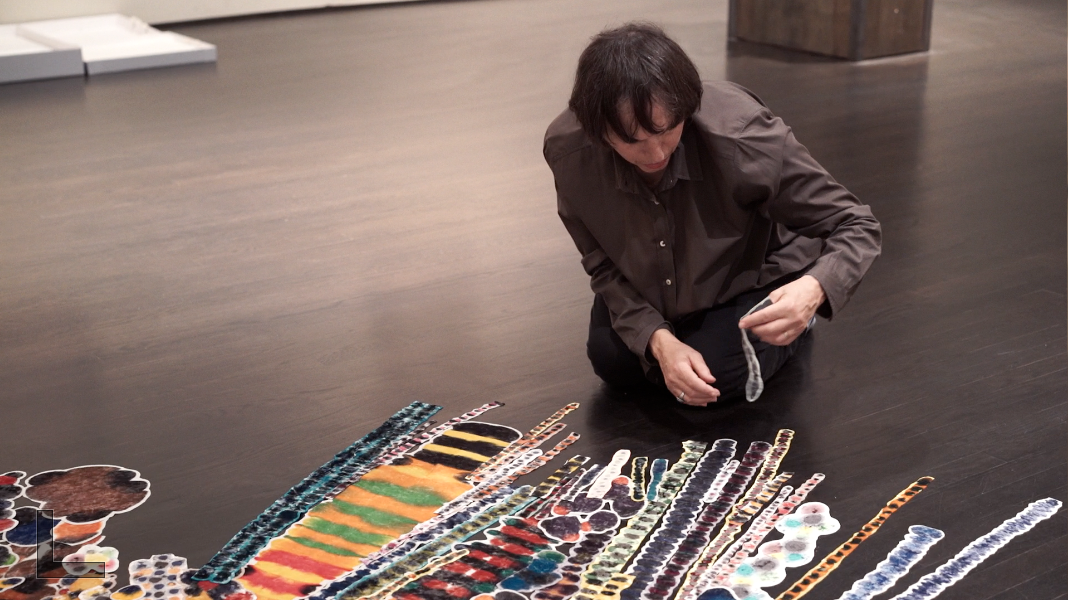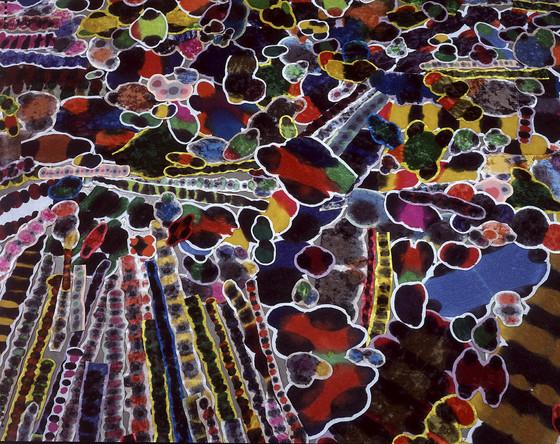Visitors to Level 2 of LACMA’s Ahmanson Building won’t have a hard time spotting Polly Apfelbaum’s floor installation Black Flag (2002), literally spilling out of the exhibition An Irruption of the Rainbow: Color in 20th-Century Art. The artist installed the work last month, arranging thousands of fabric dots, strips, and other shapes dyed in riotous colors on the gallery floor, piece by piece. I sat down with Apfelbaum to discuss Black Flag and the ideas underlying its outward chaos.

How did you arrive at the title for this piece (a reference to the Southern California punk band Black Flag)?
I’m a big music fan, and at the time I was listening to a lot of punk rock. It was also a time when a lot of intense things were happening politically – it was a sort of black time. I’ve had a lot of “music” titles, and it wasn’t necessarily for California, but Black Flag was a California band and I am glad the piece ended up in L.A.
Formally, every piece has a color dyed to black on it [meaning the fabric is first dyed black, and then dyed with a color]. I was surprised that the colors are more vibrant when you dye to black. I originally thought you would go darker but you’re going brighter. That made an interesting reference to noise. But also, in punk rock, sometimes when you think there’s no structure in the music, there is some kind of underlying structure. And so a lot of my works [like Black Flag] are improvisational in the doing, but there’s always a strong structure. There are lines that work as a structure, kind of a skeleton.
What led you to create pieces like Black Flag?
I was dying stains on big hunks of fabric, so the earlier works are more 3D “spills.” Then I thought, what happens if I cut the white out, the un-dyed parts, and just have the stains? They were beautiful shapes, and so I thought the shapes could become my paintbrush marks. At that point I started dying and cutting out a lot of shapes in all sizes to make a whole floor piece. If you think of this as a painting or a “floor painting,” then each piece of fabric is a paint stroke.
I love the idea that I sort of got rid of the “fat.” I didn’t just cut freeform. I was following the dyed shapes. So in a piece like this, I dye on a big piece of fabric and cut the shapes out of it, but I always leave a little bit of the fabric around the shape, so you can see the original fabric. Originally this work was contextualized as often with painting as with sculpture; it’s always a hybrid thing. But Black Flag has also been in drawing shows—drawing with scissors—that’s when the whole idea of line came into this, mixing line with form. I consider cutting fabric a form of drawing or even collage.

This exhibition focuses on color. How did you choose the range of colors for Black Flag?
What I love is combining colors and the whole idea of potential: you don’t know what you’ll get. At the time I was working on these pieces, I could get 103 colors of commercial dye, which is kind of amazing. A lot of the material is remnant material and scrap. And you have to look carefully, but I dye on colored fabric sometimes. The rule with the fabric is “whatever I can get,” and then I had 103 colors [of dye] that I could use.
I always say these are my “loud, obnoxious” pieces because the fabric I used at the time—and I can’t get this fabric anymore—was crushed stretch velvet, which is completely synthetic. So all the color is totally artificial, and that’s sort of like new music: totally artificial and making sounds that you don’t even know you’re going to get. I love that connection to music and improvisation and sound.
Can you tell us more about why you worked with crushed velvet for Black Flag?
Some of the velvets are more luminous, and some of the fabric is not so “crushed.” The fabrics give you a range of tactility, and also a kind of unpredictability in the form from one piece of material to another. You don’t know what you’re going to get until it’s really done, and even then the light on the crushed fabric is hard to describe. It doesn’t feel fixed.

None of the individual fabric pieces are fastened to each other in any way. Is that so the piece can be adapted to each new space where it’s installed?
Yes, and I always say gravity is my best friend! But you know, when I started these pieces, I loved this idea of malleability in form—that everything can change and nothing’s set in stone. That was really important to me early on with my work. It isn’t sculpture up there on a pedestal; it’s on the floor, vulnerable, low down, of a different nature.
In the installation process, do you follow a plan from the beginning, or do you explore the space as you go along?
I do sketch it out, and the stained lines are very important. Sometimes [in the process] I’ll say, “Oh, it looks like the drawing!” So when I was working, that idea was there and I followed it, but that kind of surprises me. I don’t feel I have to follow a plan, I just like to have one.
This is the first time I’ve ever installed one of these pieces where I have not used every single piece [of fabric]. And I thought that’s okay. I’d rather it be out in the world, a little bit unpredictable. If it can change shape, it can change size. This installation was a new experiment.
What makes this particular installation of Black Flag unique?
I like that it comes out [of the gallery]. It depends on where you are because it’s an optical illusion, too. Where you’re standing [facing the entrance to the Irruption of the Rainbow gallery] is probably my favorite perspective, because it feels like… zhooop! It’s coming at you! It’s alive! It took me a while to get used to that shape. It’s never been this shape. You have to go with the flow. That’s important, to sometimes “unfollow” your rules. That’s the nature of the work.
It’s nice, too, because I don’t think this piece has ever been on a dark floor, and I love how the floor really gobbles up the color. And I love the dialogue in the room between [my piece and] art that’s not of my time. That’s unusual, I think. And as an artist, that’s a wonderful thing—when you’re installing, to look up and think, “Oh my god, there’s Miró! There’s Calder! There’s Noguchi! I’m encroaching on Noguchi’s territory!”
One of my favorite things about this piece is that it’s never really finished in a permanent sense, because it actually takes a lot of work for it to become Black Flag.
Every time you’re doing this you’re re-making a piece. You’re repainting a painting. And people don’t understand how physical it is. Teaching myself to do that over the years—it’s just by doing. Creating a way of making something in public. Every artist creates a way of working, and this is the way I’ve created these pieces.
I love the idea that they’re different every time, that they’re fluid, because I’m seeing things fresh, too. I’m seeing different relationships I’ve never seen before. But you also have to give up stuff. You have to say: It’s not going to be this, but it’s going to be an adventure and we’ll see where that goes.
Polly Apfelbaum on Black Flag from LACMA on Vimeo.
This conversation was condensed and edited for clarity. An Irruption of the Rainbow: Color in 20th-Century Art is ongoing in the Ahmanson Building.
*



